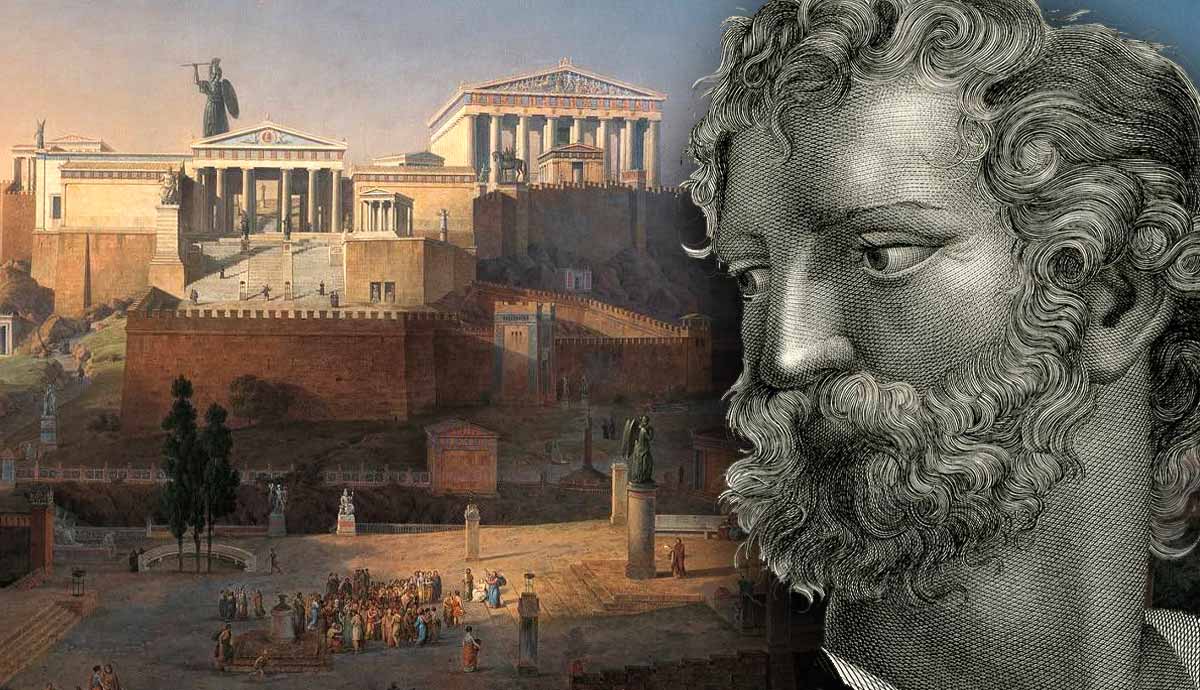
What is the soul? What are its elements? How does it relate to the body? For Aristotle, the soul is the concept in which the mind (and much else) is subsumed. This article attempts to explain Aristotle’s concept of the soul, and thereby introduce other key concepts in Aristotelian philosophy: the way he understands the relationship between form and matter, the importance of desire, and how the soul should be categorized.
The Elements of the Soul According to Aristotle

For Aristotle, the soul is an entity of extreme complexity. The enumeration of the soul’s functions requires extensive philosophical machinery and some fairly technical vocabulary. Certainly, Aristotle’s account of the soul is the most extensive and explicit of any Greek philosopher.
The soul is the mark of a living thing — if it has a soul, then it is alive, and if not, then it is not. To understand what Aristotle has to say about the soul, it is necessary to go into what is known as his hylomorphism, which is often described as the “conceptual framework” for many parts of Aristotle’s thought, as well as his theory of causation.
Hylomorphism is the relationship between matter and form, or things and their structure. To be more specific, hylomorphism holds that knowing about a thing entails knowing its matter, its form, what or who created it in this way, and its purpose.
The Concept of Causation in Aristotle

If the concept of causation in Aristotle’s work is the starting point for understanding hylomorphism, and hylomorphism is the framework by which Aristotle’s theory of the soul can be understood, then it is worth exploring the concept of causation in Aristotle.
First, there is the material cause, which — as the name suggests — refers to the material of which a thing is made. Of a certain manmade object, we might ask what material (stone, metal, wood, and so on) that object is made out of. Of course, what seems like a simple concept is actually far more complicated, given that everything — as Aristotle suggests — has a material cause. In other words, it appears that Aristotle posits an infinite regress of causes. The formal cause refers, in a similarly helpful way, to the form or structure of a thing.
Although it seems fairly obvious what counts as something’s form, this, too, is philosophically problematic. We can give plenty of examples of what counts as a form or a structure: sketches, ground plans, outlines, shapes, and so on. But actually figuring out what these things have in common, drawing out their shared features in a more explicit and concrete way, is far from straightforward.

The efficient cause is that which is responsible for the material cause arranging itself according to the structure. Often it is referred to as the “agent” responsible for this, but this is potentially a little misleading given the implication of will, decision, and other anthropomorphic qualities.
The final cause is the end or purpose of a certain thing. That everything has a purpose is a kind of long-held truism of Western culture, and it is worth noting that its roots are even older than the inception of the Christian religion.
Causes are framed as explanations — in tandem, they constitute a total explanation for a certain thing being as it is. That is, they are epistemological concepts, not metaphysical or ontological.
The relationship between Aristotle’s theory of causation and his theory of the soul is as follows. The soul is the form of the body, and the body is the material of the soul. In the simplest possible terms, this is how Aristotle’s hylomorphism relates to Aristotle’s theory of the soul.
One of the main benefits of this theory of the soul is that it appears to offer a plausible resolution to one of the most persistent problems in philosophy — that of the relation between body and soul, or body and mind in more contemporary, and therefore secular, terms. The problem itself is so challenging in part because it often doesn’t seem entirely clear that either denying that the soul/mind is just like the body or claiming that it is entirely separate from the body constitutes a sustainable, satisfying resolution to the problem.
Identity and Difference

Clearly, in Aristotle’s conception of the soul, there is neither a relation of identity nor a relation of complete difference between the body and soul — they are, in effect, different aspects of the same totality.
This conception is still popular in the philosophy of mind today and indeed appears to capture something about the subtle relationship between our minds and our bodies quite well.
Yet if the answer to the problem of how the soul and body are related were really so easily solved, there would be little controversy. When we ask what the relationship between the soul and body is, we are presumably intending to develop a theory that provides an answer to some more specific questions. For instance, the question of whether the body and soul are (in principle or in practice) separable, or whether the soul can emerge or sustain itself without a body even if it is not separable from it once they are joined.
The natural interpretation of Aristotle is that souls are not separable from bodies in fact, though they can be conceptually distinguished. In a similar way, it feels natural to say that I can separate the shape of a circle from the pie I have just made, but I probably don’t want to say that the circle is in fact (even in principle) separable from that pie. Here we have certainly moved into a kind of abstract thinking which allows very few concrete conclusions can be drawn.
Mind and Soul

It is important to clarify that, in spite of its appeal in certain ways, other elements of Aristotle’s theory of the soul seem deeply implausible today.
In particular, the implication that our soul or mind represents the organizational principles of the body is clearly a doctrine that has, at best, only a limited appeal. For the soul to be the “form” of the body in the way that Aristotle’s conception of causation implies, this would force us to find in our conception of the mind a structural concept that we might then apply to the body. Yet the structure of the mind is arguably more oblique than that of the body.
It seems true that developing a notion of something’s structure is proven in part by one’s ability to manipulate or change it ( if only in principle), and few would argue that our ability to alter the content of our minds is presently as developed as our ability to alter (to preserve, to heal, to fix, to augment) our bodies. Even though hylomorphism can, on the one hand, supply the kind of nuanced conceptual relationship which seems necessary to resolve the problem of relating the mind to the body, it also appears to effect a simplification or erasure of certain differences between the body and mind which we might not want to accept.
The Problem of Desire

Aristotle goes on to describe the various faculties of the soul: the faculties of nutrition, perception, and mind or understanding. A problem worth touching on by way of conclusion here is that of desire, and how it can be integrated into Aristotle’s theory of the soul.
Desire, for Aristotle, is difficult to integrate within any of the main faculties of the soul, and yet it is undeniable that animals appear to have a faculty for movement with purpose, movement towards not some concrete entity (as a plant grows towards the sun), but towards a certain state. This capacity for abstract intention is at the core of desire for Aristotle: “It is manifest, therefore, that what is called desire is the sort of faculty in the soul which initiates movement.” Yet the relationship between desire and our capacity to make decisions (our faculty of practical reasoning, which is a feature of the faculty of understanding) remains uncertain.

What conclusion can we draw from this? Aristotle takes the soul to be the form of the body, and so understanding the structure of the soul is absolutely paramount for our understanding of the body. Yet the structure which Aristotle sets out is complicated by desire, which is related to — but not equal to — our capacity to make decisions. In other words, Aristotle’s theory of the soul contains within it an insurgent element, and so the structure of the soul in Aristotle’s work is necessarily partial and open to further revision.











